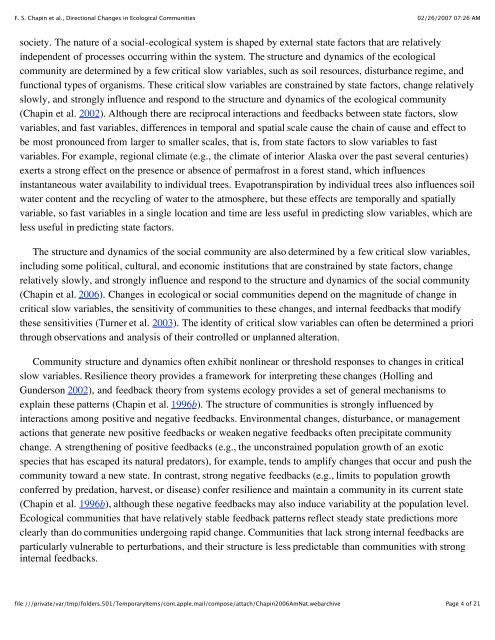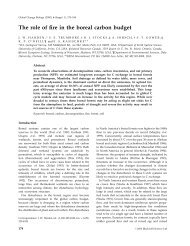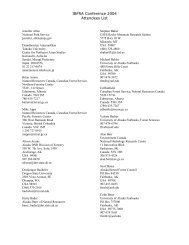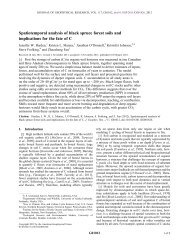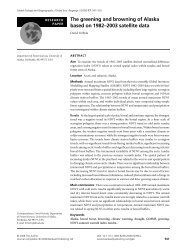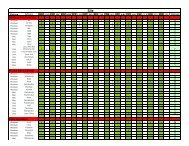Chapin, F.S., III, M.D. Robards, H.P. Huntington, J.F. Johnstone, S.F. ...
Chapin, F.S., III, M.D. Robards, H.P. Huntington, J.F. Johnstone, S.F. ...
Chapin, F.S., III, M.D. Robards, H.P. Huntington, J.F. Johnstone, S.F. ...
Create successful ePaper yourself
Turn your PDF publications into a flip-book with our unique Google optimized e-Paper software.
F. S. <strong>Chapin</strong> et al., Directional Changes in Ecological Communities<br />
02/26/2007 07:26 AM<br />
society. The nature of a social-ecological system is shaped by external state factors that are relatively<br />
independent of processes occurring within the system. The structure and dynamics of the ecological<br />
community are determined by a few critical slow variables, such as soil resources, disturbance regime, and<br />
functional types of organisms. These critical slow variables are constrained by state factors, change relatively<br />
slowly, and strongly influence and respond to the structure and dynamics of the ecological community<br />
(<strong>Chapin</strong> et al. 2002). Although there are reciprocal interactions and feedbacks between state factors, slow<br />
variables, and fast variables, differences in temporal and spatial scale cause the chain of cause and effect to<br />
be most pronounced from larger to smaller scales, that is, from state factors to slow variables to fast<br />
variables. For example, regional climate (e.g., the climate of interior Alaska over the past several centuries)<br />
exerts a strong effect on the presence or absence of permafrost in a forest stand, which influences<br />
instantaneous water availability to individual trees. Evapotranspiration by individual trees also influences soil<br />
water content and the recycling of water to the atmosphere, but these effects are temporally and spatially<br />
variable, so fast variables in a single location and time are less useful in predicting slow variables, which are<br />
less useful in predicting state factors.<br />
The structure and dynamics of the social community are also determined by a few critical slow variables,<br />
including some political, cultural, and economic institutions that are constrained by state factors, change<br />
relatively slowly, and strongly influence and respond to the structure and dynamics of the social community<br />
(<strong>Chapin</strong> et al. 2006). Changes in ecological or social communities depend on the magnitude of change in<br />
critical slow variables, the sensitivity of communities to these changes, and internal feedbacks that modify<br />
these sensitivities (Turner et al. 2003). The identity of critical slow variables can often be determined a priori<br />
through observations and analysis of their controlled or unplanned alteration.<br />
Community structure and dynamics often exhibit nonlinear or threshold responses to changes in critical<br />
slow variables. Resilience theory provides a framework for interpreting these changes (Holling and<br />
Gunderson 2002), and feedback theory from systems ecology provides a set of general mechanisms to<br />
explain these patterns (<strong>Chapin</strong> et al. 1996b). The structure of communities is strongly influenced by<br />
interactions among positive and negative feedbacks. Environmental changes, disturbance, or management<br />
actions that generate new positive feedbacks or weaken negative feedbacks often precipitate community<br />
change. A strengthening of positive feedbacks (e.g., the unconstrained population growth of an exotic<br />
species that has escaped its natural predators), for example, tends to amplify changes that occur and push the<br />
community toward a new state. In contrast, strong negative feedbacks (e.g., limits to population growth<br />
conferred by predation, harvest, or disease) confer resilience and maintain a community in its current state<br />
(<strong>Chapin</strong> et al. 1996b), although these negative feedbacks may also induce variability at the population level.<br />
Ecological communities that have relatively stable feedback patterns reflect steady state predictions more<br />
clearly than do communities undergoing rapid change. Communities that lack strong internal feedbacks are<br />
particularly vulnerable to perturbations, and their structure is less predictable than communities with strong<br />
internal feedbacks.<br />
file:///private/var/tmp/folders.501/TemporaryItems/com.apple.mail/compose/attach/<strong>Chapin</strong>2006AmNat.webarchive<br />
Page 4 of 21


